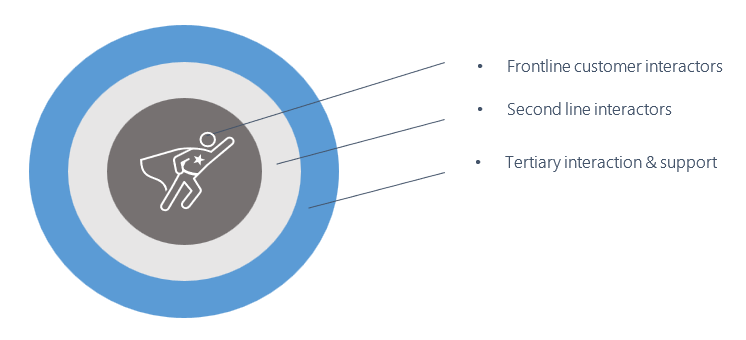Organisations are typically set up to deliver defined outcomes through a variety of departments, processes and systems. But in any single journey a customer will typically traverse several of these, and that’s not to mention channels, timelines …and everything else that’s going on for them at that point in time!
What is empathy and why is it so important in business?
We challenge our clients to change their viewpoint; to look at things from their users’ (or indeed stakeholders’) perspective. Empathy is a powerful human faculty; built on listening and understanding; and enabling transformative consideration and action. Empathising with the customer shifts the conversation from ‘it’s all about us’ to ‘it’s all about them’.
And that allows us to structure, challenge and measure impact with the perspective of the customer in mind. It’s a key component in Customer Journey Mapping, which we’ll cover in another blog post; but it’s also fundamental to challenging the organisation to think, talk and do things differently.
Empathising with the customer, end user or stakeholder not only makes emotional and human sense; it makes commercial sense too; reducing time to market and cost to serve because you’ve considered and designed for how the customer or user will interact with your service, from that person’s perspective, from the outset.
Empathising with the customer allows us to do the right thing. Empathising with our internal stakeholders ensures we get it done right
So, what’s involved?
We recognise that the best way to develop empathy is to spend time with customers, taking the time to listen and understand the context in which they operate, their motivations, and what they need from the organisation. But this isn’t always possible, and certainly not at an organisation level. So, what can we do to embed empathy across all stakeholders and relevant partners in the delivery of CX?
Follow these 4 steps to start actively bringing empathy to your organisation:
- Identify and profile the customer, user group or stakeholders that are important to you. Prioritisation can be informed by the group’s current or anticipated size, value, cost to your organisation; frequency of interaction or propensity to retain and advocate.
- Listen to those customers- either through outreach, through existing channels, or through those in your organisation who interact with them regularly. This will inform a picture of who they are, what’s important to them, and what else is going on for them that will influence their interaction with you.
- Create a customer or service user persona. This is an outline of a ‘representative’ person within the priority group. The persona gives a brief description of the customer or stakeholder demographically and psychographically, considers their motivations, and challenges, and what else might be competing for their attention, allowing users of the persona to understand, see and fully engage with the ‘full person’ for whom the service is designed.
- Build an empathy map. Considering and documenting the perspective of your user, customer or stakeholder; considering what they are hearing, seeing, doing and saying before overlaying what they are thinking and feeling with regard to your product or service is a powerful and immediate way to step into your customer’s shoes to really build that understanding of who our customers are, what they really want to achieve, and the challenges they face.
Consider too, who would be involved from your organisation…
And in doing so, consider the impact and the resulting opportunities that can be so powerful. We recommend a broad circle of engagement. However, we realise not everyone can be involved, so again it comes down to prioritisation:


- Frontline customer interactors: Who interacts most frequently with your customers, either directly or indirectly?
- Second line interactors: Who supports the frontline; think proposition and technology development teams?
- Tertiary interaction & support: Who support the second line, like business analysts and continuous improvement?
Needless to say, as you consider organisational roles that are further removed from the customer, stakeholder or end user, it can be tempting to dismiss or downplay the importance of empathy. In our experience, however, it can be those who are most distant from the customer, who can give and gain the most from empathy mapping and development. Consider the potential for positive impact that exposing your technology or billing teams to customer understanding could bring. Consider the potential that a culture of empathy could bring; the competitive differentiation, loyalty and advocacy.
Take a look at www.w5.ie to find out more about the many ways W5 works with clients to bring the customer to life for commercial success, or contact W5 at info@w5.ie to find out more about bringing empathy to life in your organisation.



